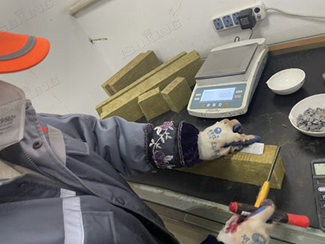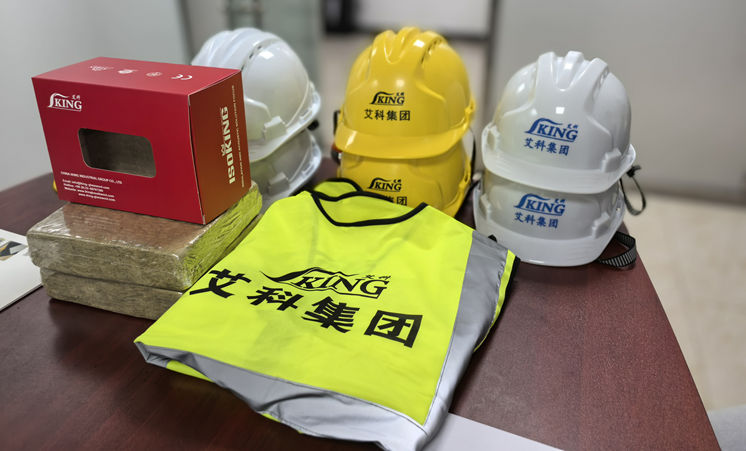IKING GROUP-INSULATION AND ACOUSTIC SOLUTION FOCUS
In the fields of building and industrial insulation, rock wool is highly favored as an efficient insulation material due to its excellent insulation, fire resistance, and sound absorption properties. However, for selecting suitable rock wool products, understanding their R value (thermal resistance value) is crucial. This article will provide a detailed introduction to the concept of R-value of rock wool, its influencing factors, and its significance in practical applications.
#What is R value?
The R-value (thermal resistance) is an indicator used to measure a material's ability to prevent heat transfer. Simply put, the higher the R value, the better the insulation performance of the material. In the construction and insulation industry, R value is one of the important parameters for evaluating the performance of insulation materials.
#The basic principle of calculating R value
R value (thermal resistance value) refers to the ability of a material to prevent heat transfer. The calculation formula for R value is as follows:
\[ R = \frac{d}{\lambda} \]
Among them:
-(R) represents the R value (thermal resistance) of a material, usually measured in square meters per Kelvin per watt [m ² · K/W].
-(d) represents the thickness of the material, usually measured in meters [m].
-Lambda represents the thermal conductivity of a material, typically measured in watts per meter Kelvin [W/(m · K)].
#Steps for calculating R value
Step 1: Determine the thermal conductivity of the material (\ (\ lambda \))
Each material has its specific thermal conductivity. The thermal conductivity of rock wool is usually between 0.035 W/(m · K) and 0.045 W/(m · K), depending on the density and manufacturing process of the rock wool. You can obtain thermal conductivity data through the following channels:
-Product specification sheet: Most insulation material suppliers will provide thermal conductivity data in the product specification sheet.
-* * Industry Standards * *: Refer to relevant industry standards or technical manuals.
-* * Laboratory testing * *: Obtain accurate thermal conductivity data through laboratory testing.
Step 2: Measure the thickness of the material (d)
Measure the thickness of rock wool board using a ruler or tape measure. Ensure measurement accuracy to the millimeter level in order to obtain accurate R values.
Step 3: Calculate the R value
Calculate the R value of rock wool according to the above formula:
\[ R = \frac{d}{\lambda} \]
For example, assuming the thermal conductivity of rock wool is 0.04 W/(m · K) and the thickness is 100 millimeters (0.1 meters), then:
\[ R = \frac{0.1}{0.04} = 2.5 \text{ m²·K/W} \]
This means that the R value of this rock wool is 2.5 m ² · K/W.
#Calculation examples in practical applications
#Example 1: Calculate the R value of a 100mm thick rock wool board
Assuming the thermal conductivity of rock wool is 0.04 W/(m · K) and the thickness is 100 millimeters (0.1 meters):
\[ R = \frac{0.1}{0.04} = 2.5 \text{ m²·K/W} \]
#Example 2: Calculate the R value of a 50mm thick rock wool board
Assuming the thermal conductivity of rock wool is 0.04 W/(m · K) and the thickness is 50 millimeters (0.05 meters):
\[ R = \frac{0.05}{0.04} = 1.25 \text{ m²·K/W} \]
#Calculation of R value for composite materials
In practical applications, it is often necessary to consider the case of multi-layer composite materials. In this case, the R values of each layer of material can be calculated separately and then added together.
For example, suppose there is a composite insulation board composed of two layers of rock wool, with the first layer having a thickness of 50 millimeters and the second layer having a thickness of 100 millimeters, both with a thermal conductivity of 0.04 W/(m · K):
The R value of the first layer of rock wool:
\[ R_1 = \frac{0.05}{0.04} = 1.25 \text{ m²·K/W} \]
The R value of the second layer of rock wool:
\[ R_2 = \frac{0.1}{0.04} = 2.5 \text{ m²·K/W} \]
Total R value of composite insulation board:
\[R_ {\ text {total}}=R1+R2=1.25+2.5=3.75 \ text {m ² · K/W} \]
#Precautions
-* * Accurate measurement * *: Ensure that the measurement of material thickness is accurate to the millimeter level.
-Source of Thermal Conductivity Data: Use reliable thermal conductivity data, preferably obtained from product specification sheets or laboratory test results.
-Multi layer material calculation: When calculating the R value of multi-layer composite materials, it is necessary to add up the R values of each layer.
I hope this information can help you accurately calculate the R value of rock wool. If you have any further questions or require more detailed explanations, please feel free to let me know
#The R value of rock wool and its influencing factors
Rock wool is a fibrous material made from natural rocks (usually basalt) through processes such as high-temperature melting, drawing, and solidification. The R value is mainly influenced by the following factors:
1. Thickness
The thickness of rock wool directly affects its R value. Generally speaking, the thicker the rock wool, the higher the R value. For example, the R value of a 1-inch (approximately 25 millimeters) thick rock wool board is about 3 to 4; The R value of a 4-inch (about 100 millimeters) thick rock wool board can reach 12 to 16.


2. Density
The density of rock wool also has a significant impact on its R value. Rock wool with higher density usually has better insulation performance. This is because high density means more fibers are interwoven together, forming more pores and reducing heat conduction. Usually, rock wool with a density between 60 kg/m ³ and 160 kg/m ³ is more common.
3. Manufacturing process
Different manufacturing processes can also affect the R value of rock wool. For example, rock wool fibers produced using continuous fibrosis technology are more evenly distributed and form a more stable insulation layer, resulting in a relatively high R value.
#Application of Rock Wool R Value
1. Residential building insulation
Application scenario: Wall, roof, and floor insulation of residential buildings.
Recommended R-value:
Wall insulation: The recommended R value is 10 to 20. For example, 2-inch (approximately 50 millimeters) thick rock wool boards (with an R value of approximately 6 to 8) can be stacked together to achieve the desired insulation effect.
Roof insulation: The recommended R value is 20 to 30. For example, a 4-inch (approximately 100mm) thick rock wool board (with an R value of approximately 12 to 16) can be used alone or in combination with other insulation materials.
Floor insulation: The recommended R value is 5 to 10. For example, 1 inch (approximately 25 millimeters) thick rock wool board (with an R value of approximately 3 to 4) can be used for insulation in basements or underground areas.
2. Thermal insulation for commercial buildings
Application scenario: Insulation of walls, roofs, and air conditioning ducts in commercial buildings.
Recommended R-value:
Wall insulation: The recommended R value is 10 to 20. For example, 2-inch (approximately 50 millimeters) thick rock wool board (with an R value of approximately 6 to 8) can be used for exterior wall insulation.
Roof insulation: The recommended R value is 20 to 30. For example, 4-inch (approximately 100mm) thick rock wool board (with an R value of approximately 12 to 16) can be used for roof insulation in commercial buildings.
Air conditioning duct insulation: The recommended R value is 5 to 10. For example, a 1-inch (approximately 25 millimeters) thick rock wool pipe (with an R value of approximately 3 to 4) can be used for insulation of air conditioning ducts.
3. Industrial equipment insulation
Application scenarios: Insulation for industrial equipment, pipelines, storage tanks, etc.
Recommended R-value:
Pipeline insulation: The recommended R value is 5 to 10. For example, a 1-inch (approximately 25 millimeters) thick rock wool pipe (with an R value of approximately 3 to 4) can be used for insulation of industrial pipelines.
Tank insulation: The recommended R value is 10 to 20. For example, a 2-inch (approximately 50mm) thick rock wool board (with an R value of approximately 6 to 8) can be used for insulation of storage tanks.
Equipment insulation: The recommended R value is 10 to 20. For example, 2-inch (about 50 millimeters) thick rock wool board (with an R value of about 6 to 8) can be used for insulation of various industrial equipment.
4. Insulation for agricultural facilities
Application scenarios: Insulation of agricultural facilities such as greenhouses, irrigation systems, heating systems, etc.
Recommended R-value:
Greenhouse insulation: The recommended R value is 5 to 10. For example, 1 inch (about 25 millimeters) thick rock wool board (with an R value of about 3 to 4) can be used for greenhouse insulation.
Irrigation system insulation: The recommended R value is 5 to 10. For example, a 1-inch (approximately 25 millimeters) thick rock wool pipe (with an R value of approximately 3 to 4) can be used for insulation in irrigation systems.
Heating system insulation: The recommended R value is 5 to 10. For example, a 1-inch (approximately 25 millimeters) thick rock wool pipe (with an R value of approximately 3 to 4) can be used for insulation in heating systems.
5. Special applications
Application scenarios: Special buildings or industrial applications, such as low-temperature storage, high-temperature equipment, etc.
Recommended R-value:
Low temperature storage: The recommended R value is 20 to 30. For example, a 4-inch (approximately 100mm) thick rock wool board (with an R value of approximately 12 to 16) can be used for insulation of low-temperature storage equipment.
High temperature equipment: The recommended R value is 10 to 20. For example, a 2-inch (approximately 50mm) thick rock wool board (with an R value of about 6 to 8) can be used for insulation of high-temperature equipment.

Installation conditions
The installation conditions of rock wool will also affect its final insulation effect. Ensuring proper installation of rock wool without gaps or uncovered areas can maximize its R-value effect.
Conclusion
Rock wool, as an efficient insulation material, its R value is an important indicator for measuring its insulation performance. Understanding the R value of rock wool and its influencing factors can help users better choose products that are suitable for specific application needs. By selecting the thickness, density, and manufacturing process of rock wool reasonably, it is possible to maximize cost-effectiveness while meeting insulation requirements.